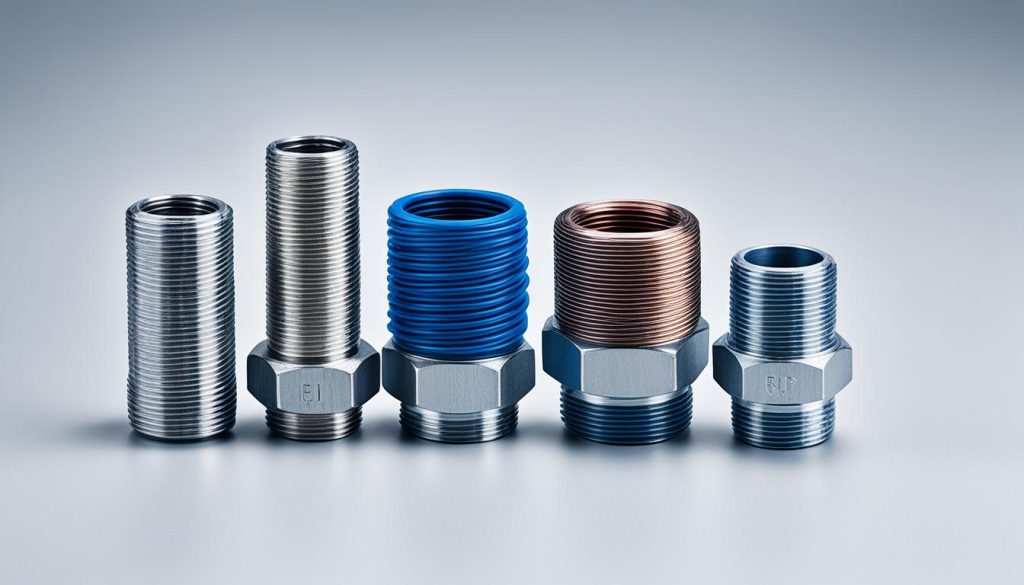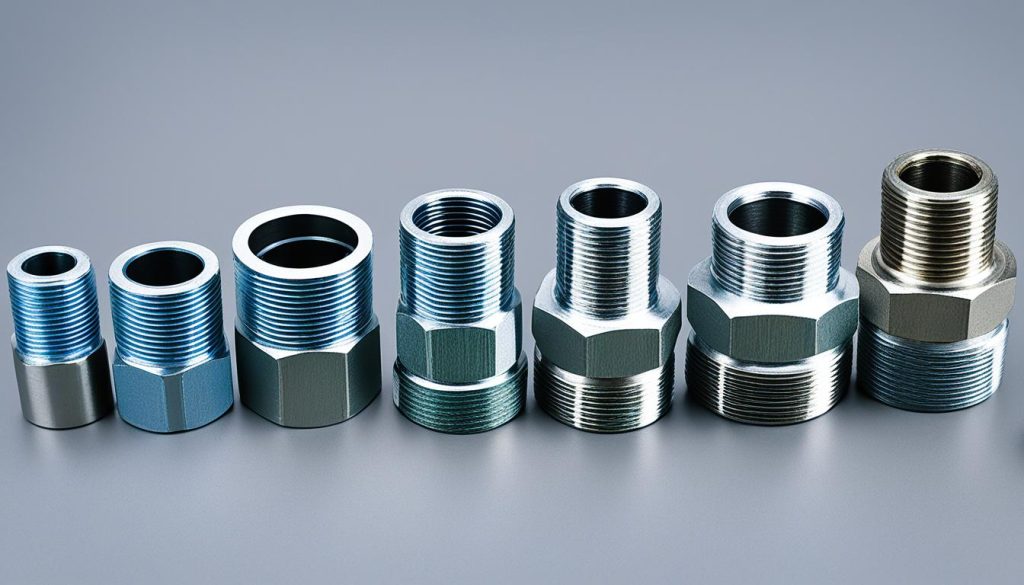MIP vs FIP: Understanding Pipe Thread Differences
Did you know that improperly sized pipe threads can result in leaks and faulty connections? It’s true! The difference between MIP and FIP threads is a crucial factor in ensuring proper fittings for your piping needs.
When it comes to pipe threads, accuracy and compatibility are vital. Using the wrong type of thread can lead to costly repairs and delays in project completion. That’s why understanding the difference between MIP and FIP threads is essential.
MIP stands for Male Iron Pipe, while FIP stands for Female Iron Pipe. These terms refer to the gender of the pipe fitting and the thread type it uses. MIP fittings have external NPT (National Pipe Thread) threads, while FIP fittings have internal NPT threads.
So, what does this mean for your plumbing or equipment installation? Knowing whether you need an MIP or FIP fitting will ensure the proper connection between pipes, valves, and other components. The thread type needs to match for a secure and leak-free joint.
Key Takeaways:
- Choosing the correct pipe thread type is crucial for secure and leak-free connections.
- MIP and FIP refer to the gender and thread type of pipe fittings.
- MIP fittings have external NPT threads, while FIP fittings have internal NPT threads.
- Matching the thread type between fittings ensures proper sizing and compatibility.
- Using the wrong thread type can result in leaks and faulty connections.
NPT Thread Size Chart
When it comes to NPT (National Pipe Thread) fittings, understanding the thread size is essential for proper installation. NPT thread sizes are commonly used in the United States and include various nominal sizes. Let’s take a look at the NPT thread size chart to determine the appropriate size for your needs.
| NPT Size | Thread Diameter (inch) | Outer Diameter (OD) (inch) | Hand-Tight Turns | Wrench Turns |
|---|---|---|---|---|
| 1/8″ | 0.405″ | 0.540″ | 3-4 | 2-3 |
| 1/4″ | 0.540″ | 0.675″ | 4-5 | 3-4 |
| 3/8″ | 0.675″ | 0.840″ | 4-5 | 3-4 |
| 1/2″ | 0.840″ | 1.050″ | 4-5 | 3-4 |
| 3/4″ | 1.050″ | 1.315″ | 5-6 | 4-5 |
| 1″ | 1.315″ | 1.660″ | 5-6 | 4-5 |
| 1 1/4″ | 1.660″ | 1.900″ | 5-6 | 4-5 |
Keep in mind that the actual outer diameter (OD) and the number of hand-tight turns and wrench turns may vary for each NPT size. Consulting a reliable NPT thread size chart will help you determine the nominal size based on the measured thread diameter.
BSP Thread Size Chart
When it comes to BSP (British Standard Pipe) threads, understanding the thread size is crucial for selecting the right fittings. BSP thread sizes are measured based on the nominal size, major diameter (OD), and minor diameter (ID). Take a look at the BSP thread size chart below to determine the correct size for your needs:
| Nominal Size | OD (Major Diameter) | ID (Minor Diameter) |
|---|---|---|
| 1/8″ | 0.383″ | 0.337″ |
| 1/4″ | 0.518″ | 0.455″ |
| 3/8″ | 0.656″ | 0.573″ |
| 1/2″ | 0.825″ | 0.725″ |
| 3/4″ | 1.041″ | 0.914″ |
| 1″ | 1.309″ | 1.156″ |
| 1 1/4″ | 1.650″ | 1.450″ |
It’s important to note that the major and minor diameter measurements may vary slightly depending on the manufacturer. Now that you have the BSP thread size chart, you can confidently identify the correct size of BSP threads for your specific application. If you’re unsure about the thread size, it’s always a good idea to consult the manufacturer or a plumbing professional for assistance.
Example Image
What are the parts of a pipe thread?
A pipe thread consists of three essential parts that play a crucial role in ensuring a proper fitting selection. These parts are the thread dimension, pitch, and thread angle. Understanding each of these elements is essential for accurately determining the right thread type and pipe size.
- Thread Dimension: The thread dimension refers to the major diameter or outside measurement of the pipe thread. It is the primary factor that determines the size of the thread. By measuring the outer diameter, you can identify the appropriate thread dimension for your application.
- Pitch: The pitch of a pipe thread is the distance between the peaks of two crests or troughs in the thread. It indicates the level of thread engagement and the tightness of the fit. Pitch is measured in threads per inch or millimeter, depending on the system being used.
- Thread Angle: The thread angle is the difference between the threads or the valley between the peaks in a pipe thread. It determines the shape and compression of the thread, allowing for a secured and leak-free connection. The thread angle is typically measured in degrees and varies based on the thread type.
By understanding the thread dimension, pitch, and thread angle, you can make informed decisions when selecting pipe fittings. This knowledge ensures proper fitting compatibility and minimizes the risk of leaks or faulty connections.
| Part | Description |
|---|---|
| Thread Dimension | The major diameter or outside measurement of the pipe thread. |
| Pitch | The distance between the peaks of two crests or troughs in the thread. |
| Thread Angle | The difference between the threads or the valley between the peaks in a pipe thread. |
Tips for assembling pipe fittings
When it comes to assembling pipe fittings, there are a few key tips to keep in mind for a successful installation. First and foremost, it is crucial to avoid cross-threading, as this can damage the threads and compromise the integrity of the connection. To ensure a smooth and secure fit, always align the threads properly before tightening.
One effective way to seal pipe threads is by using Teflon tape instead of pipe dope. Teflon tape provides a reliable barrier against leaks and is easy to apply. Simply wrap the tape around the male threads in a clockwise direction, ensuring complete coverage.
Clean fittings are essential for a reliable and leak-free connection. Before you begin assembly, take the time to thoroughly clean the fittings to remove any debris or dirt. This will help ensure a tight seal and prevent any foreign particles from interfering with the connection.
While it’s important to securely tighten pipe fittings, it is equally crucial to avoid overtightening, especially when dealing with plastic fittings. Over-tightening can lead to cracking or splitting, compromising the connection and potentially causing leaks. Use caution and stop tightening once the fittings are snug and secure.
When assembling pipe fittings, following these tips will help you achieve proper installation, minimize the risk of leaks, and ensure a reliable connection. By avoiding cross-threading, using Teflon tape, cleaning the fittings, and avoiding overtightening, you can enjoy the benefits of a well-assembled pipe system that operates smoothly and efficiently.
Source Links
- https://www.freshwatersystems.com/blogs/blog/how-to-determine-pipe-thread-type-and-pipe
- https://www.wikihow.com/Mip-vs-Npt
- https://www.certifiedaccessories.com/blogs/news/solving-the-mystery-of-plumbing-abbreviations
- Investing Wisely: How Windows & Doors in Boost Property Value and Financial Health - April 24, 2025
- The Financial Impact of Personal Injuries: Why Legal Help Matters for Business Owners - April 16, 2025
- The Hidden Financial Costs of Domestic Assault: What Business Owners Need to Know - April 16, 2025













